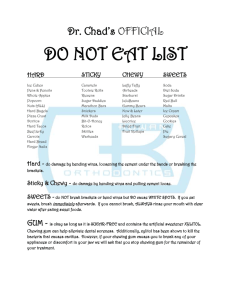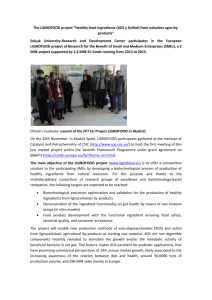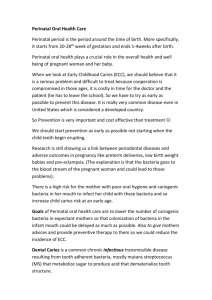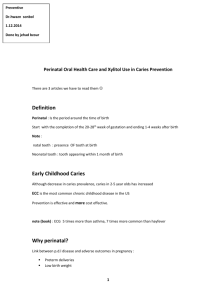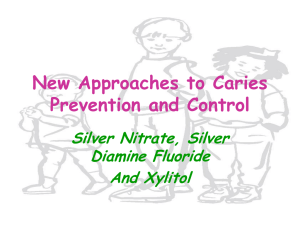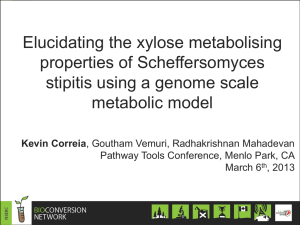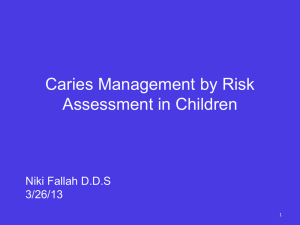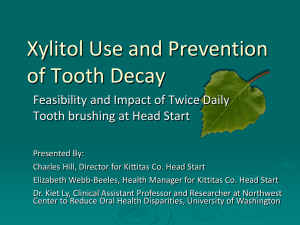abstract - Naturally Sweet Products
advertisement
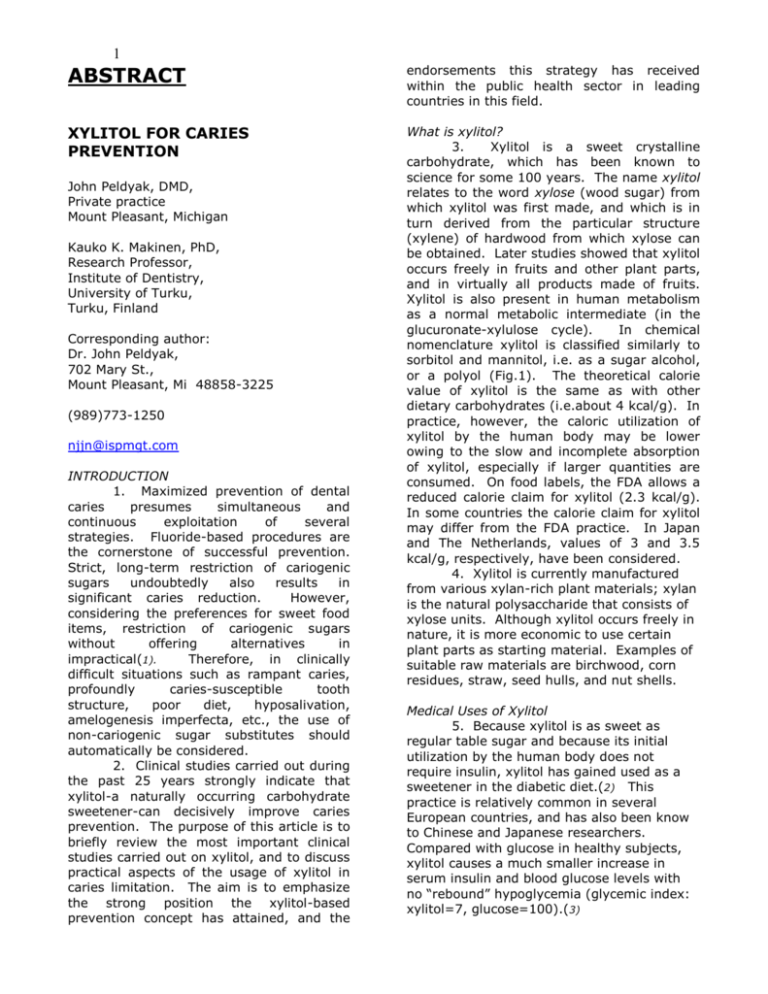
1 ABSTRACT endorsements this strategy has received within the public health sector in leading countries in this field. XYLITOL FOR CARIES PREVENTION What is xylitol? 3. Xylitol is a sweet crystalline carbohydrate, which has been known to science for some 100 years. The name xylitol relates to the word xylose (wood sugar) from which xylitol was first made, and which is in turn derived from the particular structure (xylene) of hardwood from which xylose can be obtained. Later studies showed that xylitol occurs freely in fruits and other plant parts, and in virtually all products made of fruits. Xylitol is also present in human metabolism as a normal metabolic intermediate (in the glucuronate-xylulose cycle). In chemical nomenclature xylitol is classified similarly to sorbitol and mannitol, i.e. as a sugar alcohol, or a polyol (Fig.1). The theoretical calorie value of xylitol is the same as with other dietary carbohydrates (i.e.about 4 kcal/g). In practice, however, the caloric utilization of xylitol by the human body may be lower owing to the slow and incomplete absorption of xylitol, especially if larger quantities are consumed. On food labels, the FDA allows a reduced calorie claim for xylitol (2.3 kcal/g). In some countries the calorie claim for xylitol may differ from the FDA practice. In Japan and The Netherlands, values of 3 and 3.5 kcal/g, respectively, have been considered. 4. Xylitol is currently manufactured from various xylan-rich plant materials; xylan is the natural polysaccharide that consists of xylose units. Although xylitol occurs freely in nature, it is more economic to use certain plant parts as starting material. Examples of suitable raw materials are birchwood, corn residues, straw, seed hulls, and nut shells. John Peldyak, DMD, Private practice Mount Pleasant, Michigan Kauko K. Makinen, PhD, Research Professor, Institute of Dentistry, University of Turku, Turku, Finland Corresponding author: Dr. John Peldyak, 702 Mary St., Mount Pleasant, Mi 48858-3225 (989)773-1250 njjn@ispmgt.com INTRODUCTION 1. Maximized prevention of dental caries presumes simultaneous and continuous exploitation of several strategies. Fluoride-based procedures are the cornerstone of successful prevention. Strict, long-term restriction of cariogenic sugars undoubtedly also results in significant caries reduction. However, considering the preferences for sweet food items, restriction of cariogenic sugars without offering alternatives in impractical(1). Therefore, in clinically difficult situations such as rampant caries, profoundly caries-susceptible tooth structure, poor diet, hyposalivation, amelogenesis imperfecta, etc., the use of non-cariogenic sugar substitutes should automatically be considered. 2. Clinical studies carried out during the past 25 years strongly indicate that xylitol-a naturally occurring carbohydrate sweetener-can decisively improve caries prevention. The purpose of this article is to briefly review the most important clinical studies carried out on xylitol, and to discuss practical aspects of the usage of xylitol in caries limitation. The aim is to emphasize the strong position the xylitol-based prevention concept has attained, and the Medical Uses of Xylitol 5. Because xylitol is as sweet as regular table sugar and because its initial utilization by the human body does not require insulin, xylitol has gained used as a sweetener in the diabetic diet.(2) This practice is relatively common in several European countries, and has also been know to Chinese and Japanese researchers. Compared with glucose in healthy subjects, xylitol causes a much smaller increase in serum insulin and blood glucose levels with no “rebound” hypoglycemia (glycemic index: xylitol=7, glucose=100).(3) 2 6. Another important application of xylitol is its use as a source of energy in parenteral nutrition (infusion therapy) 4. Especially German physicians have used xylitol in substantial quantities for intravenous feeding of patients with impaired glucose tolerance. When used in this way xylitol was found to have a strong anticatabolic muscle-sparing effect. 7. Xylitol can help prevent ear infections and thereby reduce the need for antibiotics. Usage of xylitol chewing gum or syrup by young day-care center subjects was associated with reduced rate of acute otitis media (middle ear infections) and with a lowered nasopharyngeal carriage rate of pneumococci in the subjects.5,6 8. Animal experiments showed that dietary xylitol improves calcium absorption and prevents osteoporosis,(7-9) (For a complete list of references regarding the effect of xylitol on bone and connective tissue metabolism, see ref. 11). Although these and other xylitol-related new observations are exciting, this review will deal with the dental aspects of xylitol. These studies have been summarized in Table 1. Several of these studies included special features which may be important to consider in clinical practice and in disseminating the necessary information to patients. Some of these aspects are: long-term effect of xylitol, hyposalivation and the dry-mouth syndrome, stabilization of rampant caries, prevention of root surface caries, the mother-child relationship from the cariologic point of view, and implementation of school prevention programs. It is also important to emphasize the advantage “regular” subjects will gain from systematic usage of xylitol-containing saliva stimulants. Even in the case of total absence of caries, xylitol is anyway dentally safer than fermentable sugars such as regular table sugar(sucrose). Dental Effects 9. More than a quarter of a century ago researchers at the University of Turku, Finland, began to study xylitol as a potential caries-limiting and an anticariogenic dietary sweetener. The initial results of simple plaque studies were encouraging. Subsequent clinical trials during the past 25 years have demonstrated that systematic usage of xylitol chewing gum and related chewable xylitol products can be associated with an impressive reduction of caries incidence both in juvenile and adult populations. These clinical trials, accompanying laboratory experiments, and outlines of the mechanism of actions of xylitol, including discussions related to the public health aspects of this approach, have been reviewed.(10-12) Special observations made in selected trials Full substitutionof xylitol for sucrose. 11. In the first clinical caries study adult volunteers were given xylitol to replace sucrose in their diet over a period of two years.(15) The second study added only a small amount of xylitol (in chewing gum to the usual diet. Both studies provided a similar result, i.e. the caries incidence had been strongly reduced in xylitol-using subjects, no matter whether xylitol diet or xylitol gum was used (Table 1). 12. These studies, collectively called Turku Sugar Studies (15). indicated that significant additional protection against dental caries can be achieved by merely using a xylitol-containing chewing gum as a saliva stimulant. Some of the advantages of the full substitution trial were the experience obtained regarding manufacturing various xylitol foods, and the confirmation of the safety of xylitol in human use. After 25 years of confirmatory trials, all of the most important observations of the Turku studies have been verified. Specific new information obtained in some of these trials will be discussed below. Clinical Evidence 10. Several long-term clinical caries studies have been successfully completed by independent research teams working on quite different human populations.(15-27) These clinical trials have shown conclusively that the consumption of a xylitol diet or the usage of xylitol-containing saliva stimulants (chewing gum and candy) reduce the incidence of dental caries significantly. The long term effect of xylitol 13. One of the confirmatory studies was carried out in the Central Finland town of Ylivieska.(22) The dental and school authorities believed that since caries prevention among the area pupils had been well executed (mostly based on the use of fluorides, systematic checkups and regular oral hygiene and dietary instructions at school), the addition of xylitol to the existing 3 preventive program would have little or no effect. The results showed, however, that the addition of the xylitol gum (in 2 to 3 daily chewing episodes) for the initially 10 to 11 year old subjects significantly increased protection against caries.(22) The teeth that erupted during the trial were especially well protected. 14. After the termination of the usage of the xylitol gum, the subjects were re-examined by the same dentists 3 and 5 years later (when the subjects were 15 and 18 years old, respectively). The preventive effect noted at the end of the trial five years earlier had persisted although the subjects no longer used xylitol gum.(23,24) Such long-term benefits of xylitol use should be considered in cost/benefit analysis of dental public health initiatives. These results have been applied in some countries (such as Finland) to develop new prevention programs for kindergartens, childrens daycare centers, military personnel, etc. Stabilization of rampant caries 15. Dentists customarily treat even small, initial caries lesions to prevent further decay. However, millions of subjects in the world live under conditions where they receive no dental care. In some areas the only dental “care” people receive is tooth extraction. On the other hand, it is known that even advanced dentin lesions can re-mineralize, or re-harden (a process called caries arrest).(28-32) This happens especially if the cavity is well open and kept free of food residues. In such instances saliva (the source of the calcium and phosphorus needed for remineralization) has ready access to the cavity. Recent clinical trials carried out in Belize, Central America, confirmed this type of caries arrest.(33) A large number of young Belizean children had open dentin and enamel carious lesions.(26) Long-term usage of xylitol chewing gum was associated with significant stabilization of these lesions. It is possible that such programmed usage of xylitol gun could alleviate pain and suffering and improve the quality of life of children with prolonged retention of the permanent teeth perhaps even until proper restorative care would be available.(33) 16. Examples of dentin caries lesions that have undergone a re-hardening process are shown in Fig. 2. Although the new occlusal surface formed in those lesions is hard (corresponding to the hardness of sound dentin or sound enamel), the hard layer is relatively thin (normally <0.1mm). This layer effectively prevents the bacteria in the underlying lesion body from receiving nutrients from saliva. The topmost layer is an apatite-like structure containing a high concentration of calcium salt largely derived from salivary calcium and phosphorus. Histologic studies suggest that contributing reactions take place within the connective tissue of the underlying sound dentin. Mother-child transmission of mutans streptococci 17. The newborn baby normally receives his/her first cariogenic organisms from the mother through normal infant-care, such as kissing and food-tasting. A long term clinical study was set up in Finland several years ago to measure the effect of mothers xylitol gum usage on the transmission rate of mutans streptococci to their babies. When the children were about three years old, the children’s risk of having mutans streptococci colonization was 2 to3 fold in the fluoridetreated group compared with the xylitol group.(34,35) The difference was statistically significant. Even at 6 years of age, the salivary mutans streptococci levels were significantly lower in the xylitol group than in the other groups which were treated with fluoride varnish or chlorhexidine varnish.(36) It is important to point out that the children did not chew gum or receive varnish treatments; only their mothers did. The same children were also examined annually regarding their caries status. At the age of 5 years, the dentinal caries (dmf) in the xylitol group was reduced by about 70% as compared with the fluoride or chlorhexidine groups.(37) It may therefore be concluded that maternal use of xylitol chewing gum can prevent dental caries in their children by prohibiting the transmission of mutans streptococci from the mothers to their children,. This mother-child study continues in Finland and will probably provide additional data during the forthcoming years. School-based xylitol programs 18. The use of xylitol in individual caries prevention is easy; the products are attractive and their use can be controlled by the subject himself or herself, or in the case 4 of small children, by guardians. Xylitol gum usage has also been tested in practice as part of school-based public health programs. In Finland, more than 40,000 elementary school pupils and now an increasing number of preschool are subjects, have been involved in supervised, systematic xylitol gum usage at school. Such efforts were initially partly based on positive observations made earlier within university and college students’ Health Foundation which found that students generally approved this type of caries prevention.(38,39) Xylitol gums are currently routinely recommended by public health centers in Finland for young children as an important caries-prevention procedure. Root surface caries 19. Prevention of cervical and root caries may constitute an overwhelmingly difficult task among certain institutionalized geriatric patients with poor oral hygiene and change-resistant attitudes. An exploratory study carried out in the Dayton, Ohio, Veterans Affairs Medical Center suggests that it may be worthwhile to offer adult and geriatric patients xylitol-based saliva stimulants (preferably hard candy). (27) Xylitol was more effective in preventing new root surface caries than sorbitol. Many of these patients abused drugs or alcohol, or they smoked. The study suggested that it may be possible to reduce the craving for tobacco, or the frequency of smoking, among such patients provided that they carry a package of xylitol-containing saliva stimulants to replace tobacco. Xerostomia 20. Some adult and geriatric patients may suffer from hyposalivation, or the dry-mouth syndrome. Many medications reduce the formation of saliva, which can be stomatologically harmful. Although the usage of xylitol-containing saliva stimulants does not offer a cure for dry mouth, systematic use of xylitol products will nevertheless alleviate the clinical situation without causing harm, as could take place if regular sucrose products are used. Although no clinical trials have been conducted in this area, it is obvious that patients with conditions such as Sjogren’s syndrome and patients who receive radiation therapy in the neck and skull area, will also benefit from systematic usage of xylitol-containing saliva stimulants. Peridontal health and xylitol 21. The caries-conductive bacterial flora is different from that associated with periodontal disease. Xylitol has been found to specifically interfere with the metabolism and adherence of mutans streptococci, and possibly of those of lactobacilli. Although xylitol inhibits the growth of several periodontopathic organisms, clinical studies have not shown that xylitol usage is as effective against periodontal disease as it is against dental caries. On the other hand, xylitol does not pose any problem periodontally, and may be beneficial .(21,41) However, none of the studies carried out has been sufficiently long lasting. Separate, longterm clinical studies should be conducted on periodontally compromised patients. The recently conducted exploratory study in Dayton, Ohio, showed that systematic usage of xylitol and sorbitol saliva stimulants was associated with improved gingival health. (27) Xylitol products are expected to be superior owing to their simultaneous effect on caries, and because of the higher sweetness and better taste of xylitol compared with sorbitol. 22. Several indirect observations do suggest that xylitol usage may exert positive effects on gingival and periodontal health. Systematic xylitol consumption generally reduces the amount of dental plaque by up to 50%.(14) Dental plaque of xylitol using subjects were found to be less inflammatory than plaque obtained from sucrose using individuals.(14,41,42) Such observations may indicate a type of inflammation-dampening effect of programmed xylitol usage. (42) Public Health Evaluation of Xylitol 23. The approach of xylitol as a caries preventive agent can no longer be regarded as experimental. Several national dental associations and other regulatory bodies in Scandinavia and elsewhere have endorsed the use of xylitol against dental caries. (13,43) Authorities in several other nations are planning to include systematic xylitol usage in various public health programs to promote better oral health. The safety of xylitol has been intensively studied in the United States. FDA classifies xylitol as a special dietary sweetener that can be consumed at levels necessary for the intended use of those products. (14,43) Xylitol has been similarly 5 approved in all industrialized nations for various medical, dietary, and cosmetic uses. Why is Xylitol effective? 24. Several texts have outlined the mechanism of action of xylitol in the prevention of dental caries.(11-14) Xylitol exerts a specific inhibitory effect on S. mutans, which is an important caries associated organism. The cells of S. mutans thrive best in acidic media and have a “sticky” surface or outer layer, enabling the organism to adhere to tooth surfaces; bacterial adherence seems to be a prerequisite of dental caries. Xylitol does not acidify plaque to any significant extent. Consequently, xylitol reduces the occurrence and adherence of S. mutans in the oral cavity, especially on tooth surfaces. Certain bio-inorganic properties of xylitol have also been implicated as possible causes of its anticariogenicity,(11,12) but for the time being the dental effects of xylitol can most easily be explained in terms of interference with the metabolism and adherence of S mutans and other cariogenic bacteria. The mechanism of action of fluorides and xylitol on dental caries differ. Fluoride and xylitol procedures can be used simultaneously with an additive effect. APPLICATIONS Commercial sweeteners, an overview 25. According to food processing convention there are two main categories of sweeteners: intense (high-potency) sweeteners and bulk sweeteners. The intense sweeteners aspartame, acesulfame K sucralose, and saccharin are many times sweeter than sucrose. They are sometimes referred to as noncaloric or nonnutritive sweeteners because of negligible caloric contribution. Intense sweeteners are favored for use in sugar-free beverages where water supplies volume. They are all considered nonacidogenic and noncariogenic. 26. In addition to sweetness, bulk sweeteners also provide useful functional properties such as volume, appearance, mouthfeel, viscosity, hygroscopicity, crystallinity, and food preservation. In the broadest chemical definition bulk sweeteners are all “sugars” or sweet crystalline cargohydrates. The main groups of bulk sweeteners are sugars (mono and disaccharides) and polyols. Sugars are readily fermented by S. mutans and other plaque organisms, capable of acidifying plaque, and considered cariogenic.(42) (An exception is the recently approved sugar D-tagatose, which is non-acidogenic.) 27. Polyols are hydrogenated reduction products of sugars, where the reducing carbonyl (C=O) aldehyde or ketone functional group is converted (reduced) to a less reactive hydroxyl (C-OH) or “alcohol group. Hence the name “sugar alcohols “ (table 2). Theoretically the higher hydrogen:carbon ratio of polyols results in less acid production than their aldose or ketose counterparts. Although the mutans group of streptococci is capable of fermenting mannitol and sorbitol, acid production is very slow and less lactic acid is produced. However both sorbitol and mannitol do normally support and stimulate the growth of these bacteria, whereas xylitol does not. 28. The FDA recently approved health claims linking the prevention of dental caries to the consumption of polyol sweetened substitutes for cariogenic snacks: “Frequent between-meal consumption of foods high in sugars and starches promotes tooth decay. (either) The sugar alcohol (name optional) used to sweeten this food may reduce the risk of dental caries. (or) The sugar alcohols in (name of food) do not promote tooth decay.” Statements for small packages include: “May reduce the risk of tooth decay.” These claims, which apply to all polyols and are not specific to xylitol, were implemented in 1998. 29. Polyols are slowly absorbed by the small intestine and metabolized along established carbohydrate pathways, mainly in the liver. The unabsorbed portion reaches the large intestine where fermentation can occur. (An exception is erythritol, a recently approved 4-carbon polyol that is rapidly absorbed and largely excreted unchanged in the urine.) Over consumption of any slowly absorbed food can result in gastrointestinal discomfort, flatulence, and osmotic diarrhea. The laxation threshold for mannitol is low and requires a warning label for anticipated ingestion of 20 grams per day, whereas the caution level for sorbitol is 50 grams per day. Xylitol is generally tolerated better than other polyols and requires no warning label. Xylitol is less extensively fermented to flatulenceprovoking breakdown products in the colon. 6 30. Most dietary sugars and polyols are structurally based on a 6 carbon hexose or hexitol unit. Xylitol, however, is a 5 carbon acyclic polyol or peititol (Fig 1.). This 5 carbon vs. 6 carbon structure is the overriding theory to explain the various clinical advantages of xylitol. The 5 carbon xylitol structure is stoichiometrically unfavorable for extensive acid (especially lactic acid) fermentation. The structural conformation makes xylitol hydrophilic and capable of forming weak interactions with calcium in solution. These complexes (also formed by sorbitol and mannitol) are believed to stabilize the calcium phosphate systems present in saliva, but are not strong enough to dissolve solid calcium salts. 31. Cyristalline xylitol dissolves rapidly (solubility of xylitol is higher than sucrose at 37 degrees C) with a pleasant refreshing cooling sensation, a clean sweet taste, and no aftertaste. Xylitol is the sweetest commercial polyol and has the greatest cooling effect. In most applications xylitol has the same sweetness as sucrose. Although xylitol is versatile and sweet enough to be used as a general purpose sucrose replacer, not all applications are rational for commercial and dental purposes. It is not necessary to replace all dietary sugars. For significant dental benefits, small amounts of xylitol can be used daily as a dietary addition or in substitutes for a few sucrose treats. Xylitol Combinations 32. Some sweetened products are not ideal candidates for xylitol. Xylitol is expensive (currently some 6 to 7 times more expensive than sucrose) and should be used mainly where dental benefits can be expected. Higher xylitol concentrations tend to give a better plaque pH response(44) and xylitol is not always able to entirely blunt a drop in pH when simply mixed in together with rapidly fermentable carbohydrates.(45) Unfavorable candidates for xylitol use are items that contain fermentable carbohydrates such as ice cream or milk chocolate (lactose), fruit candy (fructose), baked goods and cereals (cooked starch is broken down to glucose in the oral cavity). 33. Xylitol combines well with other noncariogenic (non or very slowly fermentable) ingredients for finished products that retain dental benefits at an acceptably lower cost. Non-sweet bulking agents that are dentally safe include celluloses, pectins, gums, polydextrose (randomly bonded glucose polymer), and gelatin. Intense sweeteners can be mixed with xylitol where high levels of sweetness are desired. A small percentage of xylitol can be added to beverages, usually in conjunction with an intense sweetener, to improve flavor and mouthfeel. Xylitol is added to other polyols (commonly sorbitol) for a synergistic sweetness and flavor improvement, as well as for better plaque pH response. Dentally safe syrup medications can be prepared with xylitol, usually along with thickeners and flavorings. Mint flavors are enhanced by the cooling effect provided by the addition of xylitoll. HOW TO USE XYLITOL EFFECTIVELY Product selection. 34. The best applications for xylitol are in products that encourage chewing or sucking, where xylitol is present as the sole or principal bulk sweetener (first sweeteners listed on the label). Chewing gum is considered an ideal “delivery system” for xylitol, and is the leading application worldwide. Chewing gums which are exclusively xylitol-sweetened are most effective for remineralization and caries prevention. (23) Although surprisingly small amounts of xylitol decreased caries in the Canadian study,(18,19) the lower limits for xylitol content is not well defined, and dentally insignificant levels of xylitol could be added just to boost sweetness and improve flavor and texture. In recent trials pellet type gum with a nearly pure xylitol candy coating produced the best results, perhaps because high xylitol concentrations are delivered immediately. This suggests that products other than gum are also effective, which has recently been confirmed with xylitol candy.(47) Small-piece chewy, sticky, hard, or tablet candy can be made with a high percentage of xylitol.(48) In this way xylitol can be kept in contact with the teeth for those who have trouble chewing or in situations where gum residue would be a nuisance, and the dental benefits are similar. Breath mints, antacids, calcium supplements, chewable medications, and vitamins are effectively formulated with xylitol. Compressed tablets can be almost entirely 7 xylitol, with less than 3% binder, lubricant, and flavor. In some clinical situations (tooth sensitivity, rampant caries, etc.) trays or customized mouthguards can be used to bring thick xylitol syrup into contact with all tooth surfaces simultaneously. Breath spray, oral moisturizers, and saliva substitutes are convenient vehicles to deliver small amounts of xylitol throughout the day to help relieve symptoms of xerostomia. Oral hygiene products such as toothpaste and alcohol-free mouthwash can be sweetened with a 10% or greater xylitol content. (49) How Much? 35 When used properly, very little xylitol is needed for dental benefits. A suggested range is on the order of 4 to 12 grams per day, which is 1 to 3 teaspoons, or less than one-half ounce. (This amount parallels amount of xylitol generated daily in the gluconurate-xylulose metabolic cycle.) Each “all xylitol” gum or mint contains 1 gram of xylitol or less, so a xylitolpreventive maintenance program could be as basic as chewing 1 piece of gum 4 times a day. Impressive results have been obtained in recent trials using 2 pieces of gum 5 times each day, for a daily xylitol intake of approximately 10 grams. How Often? 36. Frequency of xylitol use is more important than absolute amounts. Five times every day is recommended. Three times is considered a minimum for effective caries prevention (Fig 5.). When? 37. The ideal time to begin habitual xylitol gum chewing is at least one year prior to the eruption of permanent teeth. These teeth are most likely to be wellmineralized and maintain long-lasting protection. (50) 38. In adult patients, xylitol can be recommended after oral prophylaxis procedures. For example, following full mouth disinfection(51,52) or chlorhexidine use, xylitol can help maintain the suppression of pathogenic bacteria. (53) Timing 39. Use xylitol immediately after every meal and snack. Using xylitol between meals may also be encouraged. It is recommended that gum should be chewed for at least 3 to 5 minutes, after which time the xylitol content is practically nil. Consistent use. 40. Regular xylitol use should be encouraged as a routine healthy habit, a continuing part of a normal oral hygiene regimen. 41. These are guidelines for xylitol use. Ideally caries prevention would be individualized. Those patients who do not eat between meals, have low caries rates, low S. mutans counts, and demonstrate good oral hygiene will do well with the minimum xylitol recommendations. “High risk” patients could benefit by using xylitol more often than the standard recommendations. 42. Xylitol use is individually adjustable. Levels can be increased when other usual routine oral hygiene procedures become difficult to maintain; during illness or injury, while traveling, at school or work, and throughout orthodontic therapy. A basic xylitol program can easily be implemented on a community level such as in hospitals, nursing homes, day care centers, school cafeterias, sporting events, and the military. RECURRING QUESTIONS ABOUT XYLITOL 43. Are all sugar-free products the same? The differences are significant and justify specific recommendations for xylitol. 44. Is xylitol only recommended exclusively for children? Xylitol can be used by patients of all ages. Prevention efforts should adjust to the changing age distribution of caries onsets. 45. Is xylitol recommended only for patients with active caries? Mechanical plaque removal, fluoride, and xylitol are routinely recommended for all dentulous patients. Xylitol is also a valuable noncariogenic saliva stimulant for relief of dry mouth symptoms. Field experience suggests that xylitol can help reduce tooth hypersensitivity. 46. Who are “high risk” patients that could benefit from intensive xylitol use? More frequent use of xylitol should be recommended on clinical observation and patient history. Children who do not have 8 sealants can have similar protection with xylitol. Patients with rampant caries, poor oral hygiene, and a history of dental neglect are obvious candidates for a maximum prevention effort. Xylitol can be very helpful for special needs patients who lack manual dexterity and situations such as illness or injury where traditional home care is difficult. Extensive restorations, bridges, removable partial dentures, cosmetic restorations, orthodontic appliances, and dental implants could also make mechanical plaque removal more challenging. Consideration should also be given to patients with secondary caries, incipient caries, and gingival recession. Athletes who use sports beverages during workouts are subjected to dental erosion and may warrant more frequent use of xylitol. Within the same category are certain factory workers who may be subjected to occupational oral diseases after long-term inhaling of detrimental vapors and particles (such as acids in car battery and other plants, and sugar dust in food manufacturing plants). Intensive usage of xylitol gum has been suggested to alleviate such a situation. 47. The label states ”sugar alcohol.” Does it mean this xylitol product contains both sugar and alcohol? Unfortunately, the majority of consumers surveyed believe this. It does seem odd to claim “sugar-free” and “alcohol-free” on the same label that lists a “sugar alcohol” like xylitol. Labeling regulations distinguish between sugar alcohols, other sugars, and ethanol. Manufacturers understandably prefer to use the terms “polyols” on food labels, while the FDA maintains that “sugar alcohols” is the proper term. The term “sugar alcohol” simply pertains to organic chemistry nomenclature and is, therefore, frequently used by scientists. 48. Are there concerns about safety? Xylitol consumption has a long history of safety. The only side effects of ingesting too much xylitol are soft stools (osmotic diarrhea) in sensitive individuals. This is a limited temporary condition as dosage is self-adjusted and tolerance increases rapidly. Because individual responses vary widely, it is reasonable to begin using xylitol at the lower effective amounts. In general the laxation threshold (more than 20 grams per meal; 60 grams per day) are not even approached by the small amounts of xylitol needed for dental protection. 49. Can xylitol simply replace brushing, flossing, and fluoride? The best use of xylitol is as an adjunct to all other oral hygiene recommendations. 50. Is the use of xylitol limited to chewing gum? Xylitol is a versatile sweetener and can function as a sucrose replacer in a wide array of applications. Dental benefits have been similar in studies using xylitol candy or chewing gum. (11) 51. Can the oral bacteria adapt to xylitol? With habitual xylitol use there is a shift in the bacterial flora to a xylitol-tolerant population. This is a favorable change because these bacteria tend to be harmless. (55) 52. What are some other non-dental uses of xylitol? Xylitol is being used in a saline nasal spray to help reduce growth and adherence of pathogenic nasopharyngeal bacteria. Preliminary reports indicate reduced incidence of acute otitis media (ear infections), along with fewer upper respiratory infections.(56,57) Athletes have noted the anticatabolic musclesparing and glycogen-replenishing qualities and have used xylitol in exercise recovery formulas.(58) Maintenance of lean tissue is also important for dieters. Other appealing features of xylitol are lower calories and increased satiety. (59) 53. Is xylitol too expensive to be practical? Although raw material costs remain high, finished xylitol products cost only a little more than the sucrose products they replace. Economically disadvantaged populations often have the greatest dental needs. Targeting xylitol programs at the age when permanent teeth erupt results in long-lasting, costeffective protection. 9 SUMMARY 54. Although underutilized and often overlooked, xylitol use is compatible and complementary with all current oral hygiene recommendations. Xylitol is not a panacea, but it is a convenient, pleasant, practical, effective, and essential adjunct to “state of the art” caries prevention programs. resorption in rats. J Nutr 1996;126:19651870. 10. Svanberg M, Knuuttila MLE: Dietary Xylitol prevents ovariectiomy induced changes of bone inorganic fraction in rats. Bone Miner 1994;26:91-88 11. Makinen KK: Can the pentitol-hexitol theory explain the clinical observations made with xylitol? Medical Hypotheses 2000; 54(4)603-613. References 1. Makinen KK, Scheinin A: Sylitol and dental caries. Ann Rev Nutr 1982; 2:133-150 12. Makinen KK: Latest dental studies on xylitol and mechanisms of action of xylitol in caries limitation. In Grenby TH (ed): Progress in Sweeteners, Elsevier, NY, 331362. 1989. 2. Makinen KK: Sugar alcohols, In Functional Foods, Designer Foods, Pharmafoods, Nutraceuticals, Goldbery I, ed. New Yoruk Chapman & Hall, chapter 11, pp219-241, 1994 13. Makinen KK: Dietary prevention of dental caries by xylitol—clinical effectiveness and safety. J Appl Nutr 1991;44:16-28. 3. Natah SS, Hussein KR, Tuominen JA\, et al: Metabolic responses to lactitol and xylitol in health men. Am J Clin Nutr 1997; 65:947-950 4. Georgieff M. Moldawer LL, Bistrian BR, et al: Xylitol, an energy source for intravenous nutrition after trauma. J Parent Enter Nutr 1985; 9:199-207. 5. Kontiokari T, Uhani M, Koslela M: Effect of xylitol on growth of nasopharyngeal bacteria in vitro. Antimicrob Agents Chemother 1995; 39:1820-1823. 6. Uhari M Kontiokari I, Koskela M, et al: Xyliitol chewing gum in prevention of acute otitis media. Br Med J 1996; 313:1180-1183. 7. Uhari M Kontiokari T, Niemela M: A novel use of xylitol sugar in preventing acute otitis media. Pediatrics 1998, 102:879-884. 8. Svanberg M, Knuuttila MLE: Dietary xylitol retards bone resorption in rats. Miner Electrolyte Metab 1994; 20:153157. 9. Mattila PT, Svanberg MH, Makinen KK, et al: Dietary, xylitol, sorbitol and Dmannitol but not erythritol retard bone 14. Makinen KK: Prevention of dental caries with Xylitol – A potential dietary procedure for self care and populationlevel use in young adults. J Am College Health 1993;41:172-180. 15. Scjeinen A, Makinen KK: Turku sugar studies I-XXI. Acta Odont Scand 1975;33:suppl 70, 1-348. 16. Galiullin AN;Evaluation of the cariespreventive action of xylitol. Kazan Med J61981;67:16-18 (in Russian). 17. Kandelman D. Bar A, Hefti A: Collaborative WHO xylitol field study in French Polynesia. I. Baseline prevalence and 32 month caries increment. Caries Res 1988; 2:55-62. 18. Scheinen A, Banoczy J, Szoke J, Esztifi I, Pienihakkinen K, Scheinin U, Tiekso J, Zinuner Tnan P, Hadas E: Collaborative WHO xylitol field studies in Hungary I. Three-years caries activity in institutionalized children. Acta Onont Scand 1985: 43:327-347. 19. Scheinin A, Pienihakkinen K, Tiekso J, Banoczy J, Esztiri I, Zimmerman P, Hadas E: Collaborative WHO xylitol field studies in Hungary. VIII. Two-year caries incidence in 976 institutionalized children: Acta Odont Scand 1985; 43:381-387. 10 20. Kandelman D, Gagnon G: Clinical results after 12 months from a study of the incidence and progression of dental caries in relation to consumption of chewing gums containing xylitol in school preventive programs. J Dent Res 1987;66:1407-1411. 21. Kandelman D, Gagnon A: A 24-month clinical study of the incidence and progression of dental caries in relation to consumption of chewing gum containing xylitol in school preventive programs. J Dent Res 1990; 69:17711775. 22. Isokangas P, Alanen P, Tiekso J, Makinen KK: Xylitol chewing gum in caries prevention: a field study in children. J Am Dent Assoc 1988; 17:315-320. 23. Isokangas P, Tiekso J, Alanen P, Makinen KK: Long-term effect of xylitol chewing gum on dental caries. Comm Dent Oral Epidemial 1989;17:200-203. 24. Isokangas P, Makinen KK, Tiekso J, Alanen P: Long-term effect of xylitol chewing gum in the prevention of dental caries: A follow-up five years after termination of a prevention program. Caries Res 1003;27:495-498. 25. Makinen KK, Bennett CA, Hujoel PH, Isokangas PH, Isotupa KP, Pape JR Jr, Makinen P-L: Xylitol chewing gums and caries rates: a 40 month cohort study. J Dent Res 1005; 74:1904-1913. 26. Makinen KK, Hujoel PP, Bennett CA, Isotupa KP, Makinen P-L, Allen P: Polyol chewing gums and caries rates in primary dentition: a 24 month cohort study. Caries Res 1996; 30:408-417. 27. Makinen KK, Pemberton K, Makinen P-L, Shen E-Y, Cole J, Hujoel PP, Lopatin D, Lambert Polyol-combinant saliva stimulants and oral health in Veterans Affairs patients-an exploratory study. Spec Care Dent. 1996; 16: 104-115. 28. Herbert WE, Vale WA: Operative Dental Surgery, ed 8, London, Edward Amold Lts, p 111, 1962. 29. Curzon MEJ, Featherstone JDB: Chemical composition of enamel. In Lazzari EP (ed): Handbook of Experimental Aspects of Oral Biochemistry, Boca Raton, Florida, CRE Press, pp 123-135, 1983. 30. Fejerskov O, Thylstrup A: Pathology of dental caries. In Fejerskov O, Thylstrup A (eds): Textbook of Cariology, ed 1. Copenhagen, Munksgaard pp204-234, 1986 31. Charbeneau GT: In Principles and Practice of Operative Dentistry, ed 3. Philadelphia; Lea and Febiger. pp 26,27, 1988. 32. Sturdevant CM: In The Art and Science of Operative Dentistry, ed3. St Louis, Mosby, pp 89,97,203,295, 1995. 33. Makinen KK, Allen P, Bennett CA, Isokangas PY, Isotupa KP, Makinen P-L, PapeHR Jr: Stabilization of rampant caries: polyol gums and arrest of dentin caries in two long-term cohort studies in young subjects. Int Dent J 1995;p 45:93107. 34. Solderling et al. Influence of maternal xylitol consumption on acquisition of mutans streptococci by infants. J Dent Res 2000; 79(3): 882-887. 35. Soderling E. Isokangas P, Pienihakkinen K, Tenovuo J: Xylitol vs. chlorhexidine as reducers of mother-child transmission of mutans streptococci, J Dent Res 1996: 75:190 (Abstract 1384). 36. Soderling et al. Influence of maternal xylitol consumption on mother-child transmission of mutans streptococci: 6 year follow-up. Caries Res 2001;35: 173177 37. Isokangas et al. Occurrence of dental decay in children after maternal consumption of xylitol chewing gum, a follow-up from 0 to 5 years of age. J Dent Res 2000: Nov; 79(11): 1885-1889 38. Turtola L: A trial of adding xylitol chewing gum to a part of university students meals Finnish Student Health Service Publications 30:1-55, 1990 (In Finnish with English summary). Available from the 11 Health Service Office, Toolonkatu 37A, 00260 Helsinki, Finland. 39. M. Autio JT, Courts FJ: Acceptance of the xylitol chewing gum regimen by preschool children and teachers in a Head Start Program: a pilot study. Pediatr Dent 2001 Jan-Feb: 23(1): 7174. 40. Steinberg LM, Odusola F, Mandel ID: Remineralizing potential, antiplaque and antigingivitis effects of xylitol and sorbitol sweetened chewing gum. Clin Prev Dent 14:31-34, 1992. 41. Luostarinen V, Makinen KK, Makinen PL: Effects on oral health of xylitol, sodium cyclamate, and sucrose sweetened mouth rinses in the absence of oral hygiene.. V. Response of hamster cheek pouch Im’crocirculation of dental plaque. Proc Finn Dent Soc 1984;80:3539. 42. Makinen KK, Isokangas P: Relationship between carbohydrate sweeteners and oral diseases. Prog Food Ntr Sci 1988; 12:73-109. 43. Makinen KK: Prevention of dental caries by xylitol – issues relating to health claims. In Tillotson JE (ed): America’s Foods Health Message and Claims: Scientific, Regulatory, and Legal Issues CRC Press, Boca Raton, Fl, Chapter 12, pp 167-192, 1993. 44. Bibby BG, Fu J: Changes in plaque pH in vitro by sweeteners. J Dent Res 1989; 64:1130-1133. 45. Soderling E. Talonpoika J, Makinen KK: Effect of xylitol-containing carbohydrate mixtures on acid and ammonia production in suspensions of salivary sediment. Scand J Den Res 1987: 95:405410. children. Community Dent Oral Epidermiol 2000; 28:218-224. 48. Pepper T, Olinger PM: Xylitol in sugar-free confections. Food Technology 1988; Oct 98-106. 49. Sintes, JL, Escalante C, et al: Enhanced anticaries efficacy of a 0.243% sodium fluoride/10% xylitol / silica dentifrice: 3year clinical results. Am J Dent 1995 8: 231-235. 50. Hujoel PP, et al: The optimum time to initiate habitual xylitol gum chewing for obtaining long-term caries protection. J Dent Res 1999; 78(3) 797-803. 51. O’Hehir TE: Full-mouth disinfection. RDH 2000; 16: 78-80. 52. Bernie KM: Full-mouth disinfection. Hygiene Report 2001 May;10-13. 53. Hildebrandt GH, Sparks BS: Maintaining mutans streptococcus suppression with xylitol chewing gum. J Am Dent Assoc 2000 Jul; 131(7):909=916. 54. Alanen P, HolstiML, Pienihakkinen K: Sealants and xylitol are equal in caries protection. Acta Odontol Scand 2000 Dec; 58(6): 279-284. 55. Trahan L: Xylitol: a review of its action on mutans streptococci and dental plaque— its clinical significance. Int Dent J 1995;45:77-92. 56. Kontiokara T, Uhari M, Koskela M: Antiadhesive effects of xylitol on otopathogenic bacteria. J Antimicrob Chemother 1998; May 41(5)563-565. 57. Jones, AH: Antibiotic resistance, non-drug sugars, and bacterial adherence: can we negotiate in the war with bacteria. 2001 submitted. 46. Rekila M: Acid production from xylitol products in vivo and in vitro. Proc Finn Dent Soc 1988; 84:39-44. 58. Makinen KK: The rocky road of xylitol to its clinical application. J Dent Res 2000; 79(6):1352-1355. 47. Ananen P Isokangas P, Gutmann K: Xylitol candies ic caries prevention: results of a field study in Estonian 59. Shafer RB, et al. Effects of xylitol on gastric emptying and food intake. Am J Clin Nutr 1987; 45: 744-747.
